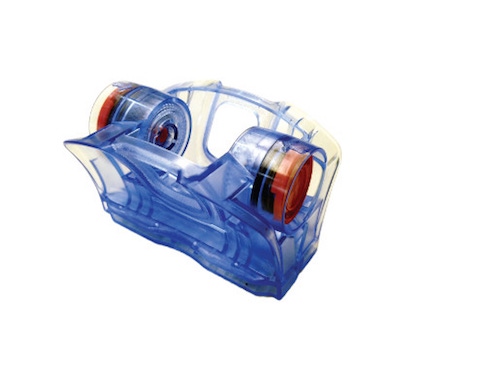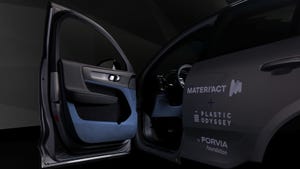June 15, 2016

Prevailing over more than 20 finalists in this year's Medical Design Excellence Awards (MDEA) program, these seven companies received the ultimate honor—a gold award—yesterday during a ceremony at the Medical Design and Manufacturing (MD&M) East trade show and conference.
Now in its 18th year, the MDEA program recognizes excellence in medical product design and engineering that improve the quality of healthcare delivery and accessibility. An impartial panel of jurors composed of clinicians, engineers and designers carefully reviewed all product submissions and awarded a bronze, silver and gold award in each category, as well as an overall best-in-show winner.
This year's best in show award went to the Flex Robotic System, a robot-assisted surgical platform from Medrobotics Corp. the gold winner in the surgical equipment category.
MD&M East, which is co-located with PLASTEC East, continues through June 16 at the Jacob K. Javits Convention Center in New York City.
The following products took home the gold this year in seven categories. All of the finalists are featured in a slide show on sister brand MD+DI’s website.
Rehabilitation and assistive technology: Indego from Parker Hannifin Corp. (Cleveland, OH)

Indego is a powered lower-limb exoskeleton enabling people with spinal cord injuries to walk and participate in over-ground gait training.
Indego has two applications. It offers clinicians a therapy tool to train spinal cord injured individuals. Furthermore, it allows users to stand and walk, and holds great promise for affording people with paraplegia a new level of independence for use outside the clinical setting.
The Indego consists of five snap-together components and weighs only 26 pounds fully assembled. The hip component houses a rechargeable battery pack, while each upper leg component houses two motors as well as embedded sensors and controllers. Bluetooth allows communication between the Indego and an iPhone or iPod touch through the custom Indego iOS application. This application enables users and clinicians to adjust device settings and to view session progress wirelessly.
Surgical equipment: Flex Robotic System from Medrobotics Corp. (Raynham, MA)
Supply/design credit: Sagentia (Boston), Manta Product Development Inc. (Cambridge, MA) and Design Standards Corp. (Charlestown, NH)

The Flex Robotic System is a robot-assisted surgical platform with a flexible scope. The minimally invasive system enables surgical access and visualization in hard-to-reach locations through a single site.
Unlike traditional “line-of-sight” approaches, the Flex Robotic System employs a flexible, robotic scope that precisely moves through the body’s natural twists and turns. Once the surgeon reaches the desired vantage point, the scope becomes rigid to form a stable surgical platform.
The on-board, high definition vision system makes it easy to see and operate with a range of flexible surgical instruments. The “wristed” 3-mm Flex instruments allow the surgeon to operate precisely in confined spaces.
Critical care: iTClamp from Innovative Trauma Care (Edmonton, AB, Canada)
Supply/design credit: MPR Associates (Alexandria, VA)

The iTrauma iTClamp provides temporary control of severe bleeding by closing and sealing the edges of a wound until it can be surgically repaired. Research studies show the iTClamp to be superior to wound packing in terms of patient survival, survival time and total blood loss, according to the manufacturer. Applied in seconds with minimal pain to the patient, the iTClamp is well suited for emergency situations.
Drug-delivery devices: Velox Electronic Nebulizer from PARI GmbH (Starnberg, Germany)
Supply/design credit shared by Design Affairs GmbH (Munich) and PARItec GmbH (Starnberg, Germany)

A reusable, cordless electronic nebulizer system, the Velox improves the quality of life of people suffering from respiratory conditions by shortening inhalation times. The device features an ergonomic design and quiet operation, and its compact size, light weight and small number of parts facilitate on-the-go use.
General hospital: Equashield from Equashield Medical Ltd. (Port Washington, NY)

Equashield is a closed-system transfer device (CSTD) used to protect healthcare workers by preventing the escape of hazardous intravenous drug or drug vapor into the environment and preserve drug sterility by preventing microbes from entering the system.
Key innovations of the device include a built-in pressure equalization system within the syringe barrel, eliminating bulky exterior air chambers; a fully encapsulated syringe, preventing major spills through accidental syringe plunger removal; a metal plunger rod, preventing hazardous drug contamination; and dry connectors between the syringe, vials and IV bags, ensuring that no drug residue escapes the system between transfers.
Diagnostics products and systems: Accelerate ID/AST System from Accelerate Diagnostics Inc. (Tucson, AZ)
Supply/design credit: Bridge Design (San Francisco)

The Accelerate ID/AST System is a diagnostic platform providing rapid identification and antimicrobial susceptibility testing of serious infections. The ID/AST platform uses a proprietary process with both genomic and phenotypic detection technologies that significantly decrease the time to result while achieving high sensitivity and specificity.
Implant and tissue-replacement: Luna Interbody Implant from Benvenue Medical (Santa Clara, CA)
Supply/design credit: JunoPacific (Soquel, CA)

The Luna 3D Implant is an in-situ expandable PEEK-Optima interbody implant that provides anterior column stability, strength and fusion with minimal neural retraction. A controlled, non-impaction delivery and generous graft window allows bone grafting material to be inserted post-expansion.
Over-the-counter: Relizorb from Alcresta Pharmaceuticals (Newton, MA)
Supply/design credit: Bridgemedica (Mansfield, MA)

Relizorb is described as a first-of-its kind digestive enzyme cartridge designed to mimic the function of pancreatic lipase. It is designed for use by adults on enteral tube feeding who have trouble breaking down and absorbing fats. Relizorb is developed using Alcresta’s proprietary enzyme immobilization technology.
Radiological and electromechanical: Analogic Sonic Window from BK Ultrasound (Peabody, MA)
Supply/design credit: Bresslergroup (Philadelphia, PA)

The Analogic Sonic Window is a self-contained, ultracompact, handheld ultrasound device. Real-time 2D ultrasound imaging allows intuitive sub-surface imaging as if the user were looking through the skin into the underlying anatomy. The Sonic Window enables clinicians to easily detect the locations and sizes of fistulas and grafts of dialysis patients, thereby helping them significantly ease and improve the process of cannulation.
About the Author(s)
You May Also Like




